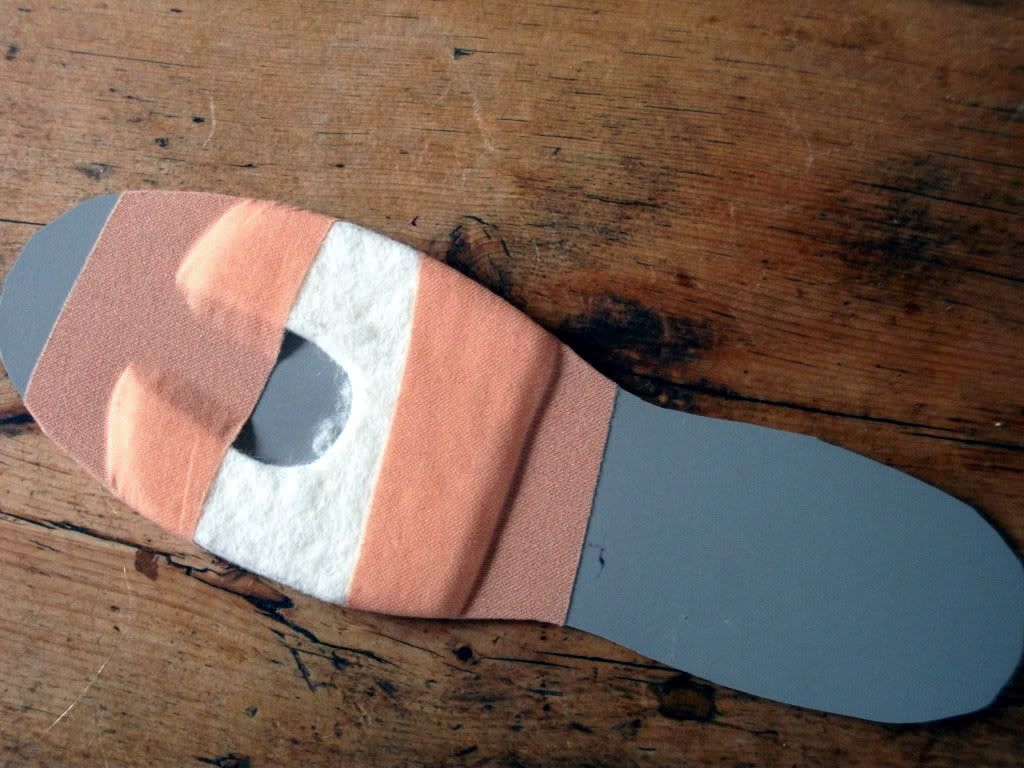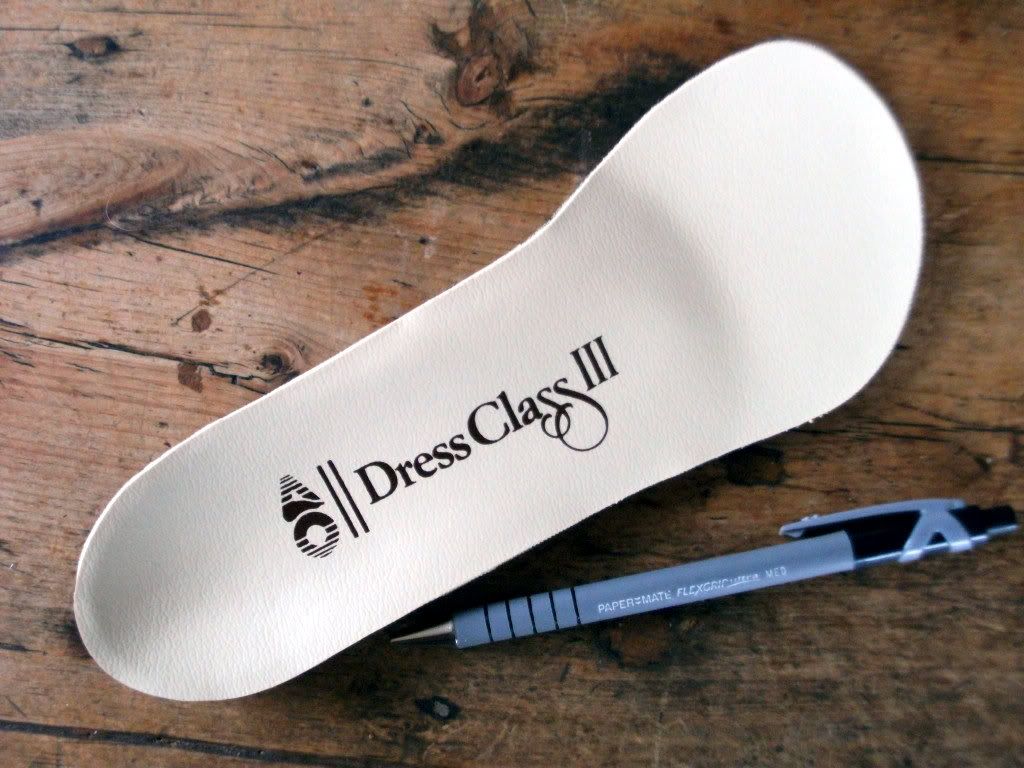Are our NHS patients being sold down the river when it comes to custom foot orthotics?
I think some of them are....
Foot orthotics combine comfort with theraputically-altered foot and lower limb function. They are effective in rehabilitation after injury, in sport, and for patients with degenerative disease like arthritis.
Like many UK Podiatrists in private practice I see the occasional patient who has had foot orthotics supplied by the NHS.
Invariably these have been of poor quality. Recently, over the last couple of years, I have noticed an increase in NHS foot orthotics with a label stuck underneath. The label says custom.
Not custom, or even "custom". Just a standard NHS insole. Offered along with the advice to the (female) client to buy some trainers because it wouldn't fit in her shoes! Some NHS Trusts are better than others in this regard.
Now custom foot orthotics are something I'm familiar with - and so I should be, having worked with them for over 20 years.
Custom foot orthotics have two specific attributes:
1. They are made from an impression of the individual patients foot, rather like making a handmade shoe from an individually-carved last.
2. They are made from materials chosen to best help the individual patient. Stiffness, resilience, springiness and cushioning are all qualities which are considered at when choosing materials for custom orthotics. Carbon-fibre, medical-grade polypropylene, high and low density foams, and anti-bacterial coverings are just some of the materials used.
I have been involved in writing two medicolegal reports recently, for claimants who both had "custom" orthotics fitted by the NHS. That they were made from an impression of the claimants feet is not in dispute.
But they were not custom, not as I understand the word.
The first report concerned a claimant who was overweight, partly due to disability stemming from a road traffic accident. The NHS custom orthotics looked like orthotics to the untrained eye, but collapsed when any weight was placed on them.
They were made from a cheap and easily-machined material called EVA. There were two pairs made. The second pair didn't fit into shoes because they were so thick - they had to be to offer any semblance of stiffness.
The other report concerned a young man who had had an accident at work. He was supplied with "custom" orthotics which certainly fitted his shoes, but didn't take into account the fact that he was young, had an excellent chance of making a full recovery, and wanted to train for his favourite sport, which was hockey.
The orthotics were made from the same floppy material as the first claimant, and had the ubiquitous "custom" sticker underneath.
What is interesting is that these claimants were not being treated by the same hospital.
One was in Shropshire, the other Leicestershire. Information from colleagues leads me to believe that poor-quality foot orthotics are being fitted by the NHS up and down the country.
Our Gold Standard for clinical information is the Cochrane Reviews database, and I'm well aware that research which has been included in Cochrane has shown that there is not much difference in action between custom and inexpensive over-the counter foot orthotics. This finding would allow any cash-strapped NHS Trust to offer cheap sub-standard foot orthotics to their patients without comeback. If the manufacturers of such orthotics were to stick a little custom label on the bottom of their orthotics they could probably charge the Trust a little more.
My own view is that although the Cochrane database is an undoubted valuable source of information, in this case it is wrong. There are many reasons why research can be biased, and I believe bias is rife in this particular area.
For more information on another example of how Cochrane may not be 100% correct 100% of the time you could go here British Medical Journal (clicky)
For those lawyers contemplating costings for their clients which may involve custom foot orthotics it is important to note that if there is a need the client will already have been provided with NHS foot orthotics.
This establishes the need, which then cannot be disputed.
In most cases the Bolam principle will not apply, because the need has been established and neither the need nor the treatment principle is in question. The efficacy of the orthotics is though, and it can easily be demonstrated that the efficacy of the NHS orthotics is poor.
True custom orthotics, bearing in mind the claimant will need several pairs, and these will need replaced over a lifetime, are not inexpensive.
For more information or to contact me go here
I think some of them are....
Foot orthotics combine comfort with theraputically-altered foot and lower limb function. They are effective in rehabilitation after injury, in sport, and for patients with degenerative disease like arthritis.
Like many UK Podiatrists in private practice I see the occasional patient who has had foot orthotics supplied by the NHS.
Invariably these have been of poor quality. Recently, over the last couple of years, I have noticed an increase in NHS foot orthotics with a label stuck underneath. The label says custom.
Not custom, or even "custom". Just a standard NHS insole. Offered along with the advice to the (female) client to buy some trainers because it wouldn't fit in her shoes! Some NHS Trusts are better than others in this regard.
Now custom foot orthotics are something I'm familiar with - and so I should be, having worked with them for over 20 years.
Custom foot orthotics have two specific attributes:
1. They are made from an impression of the individual patients foot, rather like making a handmade shoe from an individually-carved last.
2. They are made from materials chosen to best help the individual patient. Stiffness, resilience, springiness and cushioning are all qualities which are considered at when choosing materials for custom orthotics. Carbon-fibre, medical-grade polypropylene, high and low density foams, and anti-bacterial coverings are just some of the materials used.
Custom orthotic made from medical grade polypropylene with anti-bacterial cover. To fit a ladies walking shoe (pen for scale).
I have been involved in writing two medicolegal reports recently, for claimants who both had "custom" orthotics fitted by the NHS. That they were made from an impression of the claimants feet is not in dispute.
But they were not custom, not as I understand the word.
The first report concerned a claimant who was overweight, partly due to disability stemming from a road traffic accident. The NHS custom orthotics looked like orthotics to the untrained eye, but collapsed when any weight was placed on them.
They were made from a cheap and easily-machined material called EVA. There were two pairs made. The second pair didn't fit into shoes because they were so thick - they had to be to offer any semblance of stiffness.
The other report concerned a young man who had had an accident at work. He was supplied with "custom" orthotics which certainly fitted his shoes, but didn't take into account the fact that he was young, had an excellent chance of making a full recovery, and wanted to train for his favourite sport, which was hockey.
The orthotics were made from the same floppy material as the first claimant, and had the ubiquitous "custom" sticker underneath.
What is interesting is that these claimants were not being treated by the same hospital.
One was in Shropshire, the other Leicestershire. Information from colleagues leads me to believe that poor-quality foot orthotics are being fitted by the NHS up and down the country.
Our Gold Standard for clinical information is the Cochrane Reviews database, and I'm well aware that research which has been included in Cochrane has shown that there is not much difference in action between custom and inexpensive over-the counter foot orthotics. This finding would allow any cash-strapped NHS Trust to offer cheap sub-standard foot orthotics to their patients without comeback. If the manufacturers of such orthotics were to stick a little custom label on the bottom of their orthotics they could probably charge the Trust a little more.
My own view is that although the Cochrane database is an undoubted valuable source of information, in this case it is wrong. There are many reasons why research can be biased, and I believe bias is rife in this particular area.
For more information on another example of how Cochrane may not be 100% correct 100% of the time you could go here British Medical Journal (clicky)
For those lawyers contemplating costings for their clients which may involve custom foot orthotics it is important to note that if there is a need the client will already have been provided with NHS foot orthotics.
This establishes the need, which then cannot be disputed.
In most cases the Bolam principle will not apply, because the need has been established and neither the need nor the treatment principle is in question. The efficacy of the orthotics is though, and it can easily be demonstrated that the efficacy of the NHS orthotics is poor.
True custom orthotics, bearing in mind the claimant will need several pairs, and these will need replaced over a lifetime, are not inexpensive.
For more information or to contact me go here

